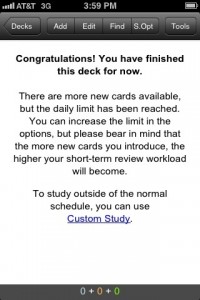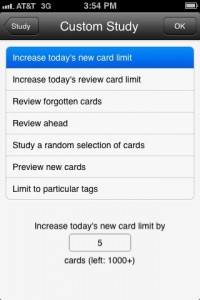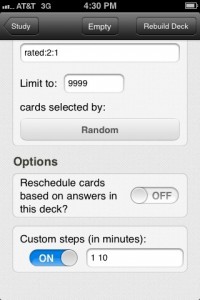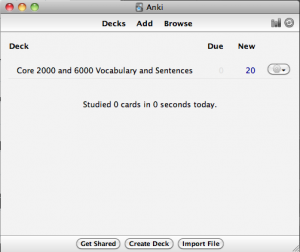I find that Anki does a very good job of scheduling cards that I’ve learned several days or weeks ago. But if I was to rely on Anki’s default scheduling for new cards, I would hardly learn anything. That’s where Filtered Decks come in.
I have my Anki new card limit set to zero, so that Anki doesn’t show me any new cards until I am ready. Every morning when I wake up, I have 50-100 review cards waiting for me. I usually try to finish up the reviews before breakfast and then I press “Custom Study” on the screen where it says I’ve finished my cards for today. Then I press Increase today’s new card limit and add 5-7 new cards to the mix at a time. If I want to add more than 7 cards, I still add them in chunks of 5-7 so I don’t get confused with too many new cards in short term memory at once. Once I’ve learned all the new cards that I’d like to learn today, I eat breakfast and let the new information sink in a little.


After breakfast, I have a filtered deck set up that lets me study all of the cards that I failed to answer at least once in the past 2 days. Presumably all of the new cards will be in this deck too since I wouldn’t have answered correctly the first time through.
To create a deck like this on iOS, click “Custom Study” and “Review Forgotten Cards”. Change the number of days to “2” and then click “OK”.
Then click “Tools” then “More” then “Study Options”.

Now switch “Reschedule cards…” to off. Make sure Custom Steps is “1 10”. and if you have more than one deck that you would like to review at once (eg kanji and vocab) delete everything in the search field other than “rated2:1”.With this deck, I can review all of the new cars and cards that I’m having trouble with.
Setting Custom steps to “1 10” will make me answer correctly twice in a row to a card before it is removed from the filtered deck. This way all of the easier cards will be removed early on, leaving me with only the cards that I really need to concentrate on.
I try to go through this deck around 5 times by pressing “rebuild deck” throughout the day, trying to space my review sessions out as evenly as possible so hopefully by the end of the day, all of the missed cards and new cards are in long term memory. By the time I do my reviews the next day, I’ll be able to answer correctly for most of the previous day’s new cards as well as the missed ones.
Sometimes, if I get too many cards in my filtered review deck, I’ll add another filtered deck with the same settings, except I’ll change to rated:1:1 to study just today’s most “forgettable” cards. If I still have too many cards in the deck, I change the limit to something like 15 or 30 and rebuild often. But I always make sure to study the rated:2:1 deck a few times each day regardless. I’ve found for my own studies, it is more efficient to study forgotten cards for two days. I’ve done one day(ie rated:1:1), but I found the time saved was more than taken up by the amount of missed cards in subsequent days.
Please leave any questions in the comments or variations if you are having success with similar methods.



